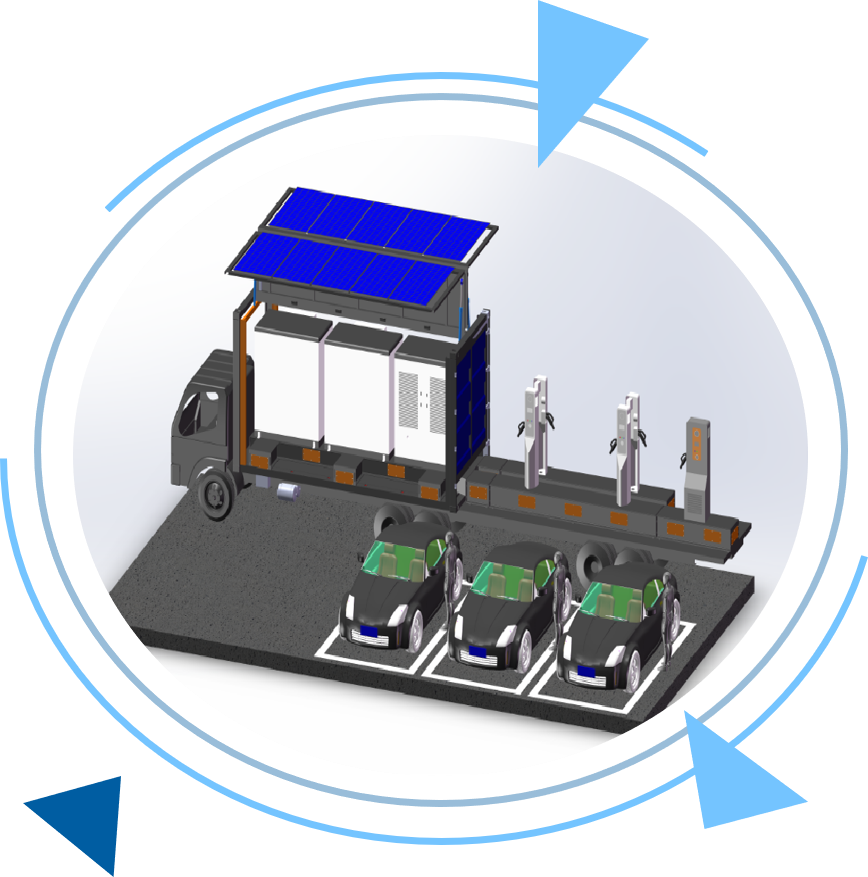About
Pilot Project to Promote the Popularization of Electric Taxis in Hong Kong with AI Microgrid and Energy Storage Super Charging Solutions

Pilot project promoting the popularization of electric taxis in Hong Kong with AI microgrid and energy storage super charging solutions, making charging more convenient than refueling, achieving a close, fast, and green charging experience.
The only certain direction and consensus between China and the US in the uncertain future of the next 50 years: promoting the vision of carbon peak and carbon neutrality with unprecedented efforts, sustainable development is the main theme of the future.
Climate Change Policy
China's 2030 Goals: Peak carbon emissions and strive to peak as early as possible, reduce CO2 emissions per unit of GDP by 60%~65% compared to 2005, and increase the share of non-fossil fuels in primary energy consumption to around 20%.
Hong Kong's Carbon Neutrality Vision
In November 2020, Hong Kong officially announced its goal of achieving carbon neutrality by 2050 in its annual Policy Address, becoming the first city in China to explicitly commit to a carbon neutrality timeline. According to the "Hong Kong's Climate Action Plan 2050" released in October 2021, the government will make every effort to overcome the constraints of Hong Kong's geographical environment and vigorously promote the development of renewable energy.
Why did electric taxis "go extinct" in Hong Kong? Some Legislative Council members and the taxi industry point out that the biggest obstacle for the industry refusing to switch to electric taxis is the lack of charging facilities.
Current Status of Electric Taxis in Hong Kong
In 2013, Hong Kong introduced over 40 BYD E6 electric vehicles from mainland Chinese EV manufacturer BYD into the taxi industry. It is said that at its peak, a total of 48 BYD electric taxis were in operation. At that time, Hong Kong electric taxis received a subsidy of HK$300,000, but drivers generally reported long charging times, needing 2.5 hours of charging for a 12-hour workday, and earning HK$200 less per day than fuel taxis. Coupled with difficulties finding charging stations, slow charging, insufficient range, and rapid tire wear, drivers resold their electric taxis after the two-year cooperative trial period ended.
Insufficient Charging Facilities
Legislators point out that insufficient charging facilities hinder the taxi industry from replacing vehicles with electric taxis and urge the government to improve related supporting facilities. They worry that charging time will affect livelihoods, thus urging the government to improve charging facilities and promote electric taxis and green transport. In recent years, the number of fast charging facilities has been small and has grown slowly, with only 500 added in four years. As of the end of last year, Hong Kong had less than 1,000.
Three core technologies of the AI-driven super charging solution for low-carbon transport and renewable energy: AI (Artificial Intelligence), PV-Storage-DC Flexible & V2G Smart Microgrid System based on reserve energy storage batteries, and Digital Twin prediction and optimization for the transport-energy system.
AI Artificial Intelligence
Over ten years of accumulated data and models on EV power battery usage, extensive algorithm models have been developed for cascade utilization of power batteries, energy storage system control, full lifecycle fault prediction, performance maintenance, and upkeep, already commercially applied at Shenzhen Bus Group and Toyota Hino TS.
Smart Microgrid System
PV-Storage-DC Flexible & V2G Smart Microgrid System based on reserve energy storage battery measurement and optimization, integrating energy storage systems and photovoltaic systems through an energy management system. It manages energy strategies based on local new energy policies and actual operational conditions, achieving a real-time basic balance between local power generation and charging load.
Dual-Layer Power Pool
Power sharing matrix + smart power allocation is key to improving parking space utilization and grid capacity, maximizing power utilization through a dual-layer power pool to cover more parking spaces with the same power capacity.
Products and Business Models of the AI-Driven Super Charging Solution for Low-Carbon Transport and Renewable Energy: Integration of low-carbon smart transportation and green renewable energy, real-time transport-energy optimization, green energy wholesale and retail.
Products and Services
Low-Carbon Commercial Driving Brain (EBOX), Smart Transport Energy Platform, through joint 2B2C operation, no investment required from Party A, revenue sharing, achieving integrated investment, construction, management, and operation.
Business Model Innovation
Haylion Technologies takes responsibility for the investment, construction, management, and operation of the project based on the commercial center's transport energy expansion needs, and shares revenue with the property owner. This achieves a green transport energy transition without bearing any investment risk, through a new operating model of green energy wholesale and retail based on PEDF energy storage.
Benchmark Project
Shenzhen SCPG Center Construction: 2MW distributed photovoltaic power station, 824kW distributed energy storage, AC/DC power distribution system, smart microgrid, dynamic power distribution, DC supercharging and fast charging covering nearly a thousand parking spaces at SCPG Center, VPP virtual power plant, peak shaving and valley filling V2G, power battery testing, transport energy management platform, charging pile operation platform.
Establish a new category for electric taxi charging mode trial projects under the Environmental Protection Fund's "Application Trial", supporting the taxi industry in finding the most suitable charging solutions for its operations, investing HK$30 million to build 3 demonstration projects.
Hong Kong Beacon Hill PV-Storage-DC Flexible Super Charging Station
Innovation points of the Hong Kong Beacon Hill PV-Storage-DC Flexible Super Charging Station design: A super charging system based on PV-Storage-DC Flexible V2G technology, integrating distributed photovoltaic power generation, energy storage systems, and smart energy management, capable of providing high-power fast charging services.
Hong Kong Electric Taxi Home
Innovation points of the Hong Kong Sai Ho Yuen PV-Storage-DC Flexible Super Charging Station design: A charging service center specifically designed for electric taxis, providing efficient fast charging, driver rest areas, and related supporting services to meet the charging needs of taxi operations.
Hong Kong Fairview Park PV-Storage-DC Flexible Super Charging Station
Innovation points of the Hong Kong Fairview Park PV-Storage-DC Flexible Super Charging Station planning layout: A community-type PV-Storage-DC Flexible super charging station serving surrounding residents and passing vehicles, maximizing resource utilization. The system features real-time upload, unlimited unit quantity, direct cloud connection, no need for a centralized control center, no on-site maintenance, saving 30%~40% in costs.
Shenzhen Haylion Technologies Co., Ltd. is a Sino-foreign joint venture high-tech company initiated and invested by Shenzhen Bus Group, Guangdong Private Investment Co., Ltd., Scania (Volkswagen Group), Hino Motors (Toyota Group), and an entrepreneurial team composed of senior experts from fields such as urban public transport, artificial intelligence, computer and communication, and automobile manufacturing.
Company Vision and Mission
Company Vision: Provider of integrated solutions for low-carbon smart transportation and green renewable energy
Company Mission: To make urban green, low-carbon, smart transportation the first choice for public travel.
The company has obtained a total of 48 authorized patents, including 18 invention patents, 25 utility model patents, and 5 design patents.
Strong Shareholder and Investor Background
Shareholder Structure: Guangzhou Yuemin Investment Zhihai Equity Investment Partnership (26.571%), Shenzhen Bus New Energy Co., Ltd. (9.604%), Wuhan Karuitong New Energy Vehicle Industry Investment Partnership (4.802%), Scania CV Aktiebolag (Volkswagen Group) (1.96%), Hino Motors, Ltd. (Toyota Group) (2%), Natural Person Shareholders (Management Team) (55.063%)
Investment Amount (HK$ Million)
Number of Demonstration Projects
Number of Participating HK Universities
Target Year for Introducing 3,000 Electric Taxis in HK

Hu Jianping
Chief Executive Officer of Haylion TechnologiesFounder of eMaaS, Founder and Chairman of Haylion Technologies, Chief Expert of the Urban Passenger Transport Expert Committee of China Road Transport Association, Ph.D. in Road and Traffic Engineering from Tongji University. Previously served as General Manager and Chairman of Shenzhen Bus Group Co., Ltd., Executive Deputy General Manager of Shenzhen Metro Group Co., Ltd., Assistant to Director and Head of Personnel Department of Shenzhen Government Transport Bureau, Vice Chairman of China Road Transport Association, and Senior Vice President of Microvast Power Systems (USA).

Qiu Jiandong
Senior Engineer of SUTPCDirector of Transportation Information and Model Institute, High-level Leading Talent of Shenzhen. 17 years of experience in traffic modeling and big data. Led over 30 urban modeling and big data platform projects and 10 national and provincial research projects. Authorized 30 patents, co-authored 5 monographs and industry standards, published 35 papers, and received 24 national and provincial awards.

Ke Jintao
Assistant Professor of HKUServes as Youth Editor of TRC and Editor of TRE, leading international journals in transportation. Led multiple research projects, including National Natural Science Foundation, Hong Kong Transport Department Smart Transport Fund, Hong Kong Research Grants Council Fund, and Hong Kong Environmental Protection Department Green Fund, with total funding exceeding HK$10 million. Published over 50 SCI/SSCI papers with over 4,900 citations, ranked among the World's Top 2% scholars in Smart Transportation by Stanford in 2023.